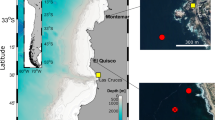Abstract
Recent studies on global climate change report that increase in seawater temperature leads to coastal ecosystem change, including coral bleaching in the tropic. In order to assess the effect of increased seawater temperature on a temperate coastal ecosystem, we studied the inter-annual variation in productivity of Laminaria japonica using long-term oceanographic observations for the Uwa Sea, southern Japan. The annual productivity estimates for L. japonica were 2.7 ± 2.5 (mean ± SD) kg wet wt. m−1 (length of rope) (2003/2004), 1.0 ± 0.6 kg wet wt. m−1 (2004/2005) and 12.1 ± 12.5 kg wet wt. m−1 (2005/2006). Our previous study using the same methodology at the same locality reported that the productivity was estimated for the 2001/2002 (33.3 ± 15.2 kg wet wt. m−1) and 2002/2003 (34.0 ± 8.7 kg wet wt. m−1) seasons. Productivity in 2003/2004 and 2004/2005 was significantly lower than in years 2001/2002, 2002/2003 and 2005/2006. A comparison of oceanographic conditions among the 5 years revealed the presence of threshold seawater temperature effects. When the average seawater temperature during the first 45 days of each experiment exceeded 15.5°C, productivity was reduced to about 10 % of that in cooler years. Moreover the analysis of growth and erosion rates indicates that when the seawater temperature was over 17.5°C, erosion rate exceeded growth rate. Thus, an increase of seawater temperature of just 1°C during winter drastically reduces the productivity of L. japonica in the Uwa Sea.


















Similar content being viewed by others
References
Coles SL, Brown BE (2003) Coral bleaching-capacity for acclimatization and adaptation. Adv Mar Biol 46:183–223
Hasegawa M, Koizumi K, Konagaya T, Noda M (2003) Grazing of herbivorous fish as a continuous factor of Isoyake off the coast of Hainan, Shizuoka Prefecture. Bull Shizuoka Pref Fish Exp Stn 38:19–25
Hiraoka M, Ura Y, Haraguchi H (2005) Relationship between seaweed beds and seawater temperature in the Tosa Bay. Aquabiology 27(5):485–493
Hoegh-Guldberg O, Salvat B (1995) Periodic mass-bleaching and elevated sea temperatures: bleaching of outer reef slope communities in Moorea, French Polynesia. Mar Ecol Prog Ser 121:181–190
IPCC (2001) Climate change 2001: the scientific basis. Cambridge University Press, Cambridge, p 881
Japan Meteorological Agency (2006) Long-term variation in surface seawater temperature. http://www.data.kishou.go.jp/kaiyou/shindan/a_1/glb_warm/glb_warm.html
Jokiel PL, Brown EK (2004) Global warming, regional trends and inshore environmental conditions influence coral bleaching in Hawaii. Glob Chan Biol 10:1627–1641
Jones RJ, Hoegh-Guldberg O, Larkum AWD, Schreiber U (1998) Temperature-induced bleaching of corals begins with impairment of the CO2 fixation mechanism in zooxanthellae. Plant Cell Env 21:1219–1230
Kawabata Z, Shiba S, Sotomaru Y, Kusumoto D, Ohgaki N, Nakashige E, Udaka N, Kuranishi M, Shimizu N, Yamamoto C (1998) Water quality monitoring in Usu Bay. In: Report on environmental survey of aquaculture ground in Uwajima Bay 1984–1998. Usu Fishery Cooperative Union, Ehime, Japan, pp 603–644
Kawashima S (2004) Laminariales. In: Ohno M (ed) Biology and technology of economic seaweeds. Uchida Rokakuho Publishing Co., Ltd., Tokyo, Japan, p 575
Kinoshita T (1947) Research on enhancement of Laminaria and Undaria. Hoppo Press, Sapporo, Japan, p 79
Kirihara S, Nakamura T, Notoya M (2003) Effect of water temperature on the growth of Laminaria japonica (Laminariales, Phaeophyceae) at the coast of Siriyazaki, Shimokita Peninsula, Japan. Suisanzoshoku 51(3):273–280
Kitadai Y, Kadowaki S (2003) The growth process and N, P uptake rates of Laminaria japonica cultured in coastal fish farms. Suisanzoshoku 51(1):15–23
Kiyomoto S, Yoshimura T, Arai S, Kiriyama T, Fujii A, Yotsui T (2000) Recovery of Ecklonia kurome after the occurrence of blade disappearing phenomenon at Nomozaki, Nagasaki Prefecture. Bull Seikai Natl Fish Res Inst 78:57–65
Lüning K (1981) Light. In: Lobban CS, Wynne MJ (eds) The biology of seaweeds. Univ. of Calif. Press, CA, pp 326–355
Maita Y, Mizuta H, Yanada M (1991) Nutrient environment in natural and cultivated grounds of Laminaria japonica. Bull Fac Fish Hokkaido Univ 42(3):98–106
Nakayama Y, Arai S (1999) Grazing of the brown alga Ecklonia cava by three herbivorous fishes on the coast of Nakagi, South Izu, central Japan. Jpn J Phycol 47:105–112
Obura DO (2005) Resilience and climate change: lessons from coral reefs and bleaching in the Western Indian Ocean. Est Coastal Shelf Sci 63:353–372
Ohno M (1987) Present seaweeds cultivation. In Tokuda H, Ohno M, Ogawa H (eds) The resources and cultivation of seaweeds. Midori Syobo Co., Ltd., Tokyo, Japan, p 354
Okada Y, Sanbonsuga Y (1980) Effects of temperature on the growth and maturation of female gametophytes of Laminariaceous plants. Bull Hokkaido Reg Fish Res Lab 45:51–56
Sabatés A, Martín P, Lloret J, Raya V (2006) Sea warming and fish distribution: the case of the small pelagic fish, Sardinella aurita, in the western Mediterranean. Glob Chan Biol 12:2209–2219
Short FT, Neckles HA (1999) The effects of global climate change on seagrasses. Aquatic Botany 63:169–196
Suzuki S, Takeuchi I (2007) Inter-annual variation in seawater temperature off the Uwa Sea coast, Ehime Prefecture. La mer 45:35–46
Suzuki S, Furuya K, Takeuchi I (2006) Growth and annual production of the brown alga Laminaria japonica (Phaeophyta, Laminariales) introduced into the Uwa Sea in southern Japan. J Exp Mar Biol Ecol 339:15–29
Tsuda F, Agatsuma Y, Taniguchi K (2006) History and current state of “Isoyake” phenomenon along the Japan Sea coast in Hokkaido, Japan. Kaiyo Monthly 38(3):210–215
Acknowledgements
The present study was partially supported by the special research found from Faculty of Agriculture, Ehime University.
Author information
Authors and Affiliations
Corresponding author
Rights and permissions
About this article
Cite this article
Suzuki, S., Furuya, K., Kawai, T. et al. Effect of seawater temperature on the productivity of Laminaria japonica in the Uwa Sea, southern Japan. J Appl Phycol 20, 833–844 (2008). https://doi.org/10.1007/s10811-007-9283-3
Received:
Revised:
Accepted:
Published:
Issue Date:
DOI: https://doi.org/10.1007/s10811-007-9283-3




